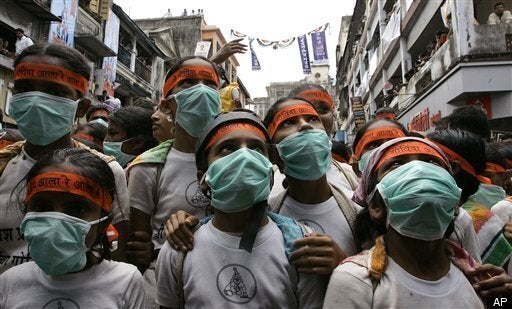
Even if India could stave off the worst influences of the global economic meltdown, it still could not halt at its borders the spread of the newest pandemic of flu virus, the H1N1. Called the Swine Flu, for a while it seemed that it could be contained at the entrepots of the country where the incoming passengers could be quickly quarantined and segregated from the general population.
Both the government and the watchdog media had lowered their guard after the first few cases were quickly discovered and promptly sequestered in tight compartments. It had seemed that like all the ills of globalization, this too has been contained. But then early this week, a young school-going girl in Pune, Maharashtra -- a city adjacent to Mumbai -- died of the flu. All hell broke lose from then on. The media also threw down its gauntlet at that point.
It can be debated that in a country of 1.1 billion people, the total number of diagnosed Swine Flu cases were statistically inconsequential, but considering this is an affliction of the voluble urban population, this got set in the minds of the television news executives as the news that would get garner the highest TRP. So, day in and day out, morning, noon and night, news television provided saturation coverage of the various facets of the flu.
It had begun by depicting the grief of the parents of the first victim in Pune. The grief-stricken parents were also angry at the hospital that had treated the girl. They had even acquired a lawyer to sue the otherwise famous hospital who threatened each time he appeared on television with suing the authorities of the hospital "for a huge sum of money."
The urban circus that unfolded showed the next day thousands of Pune's citizens out on the streets with cloth masks covering their faces, queuing up in front of a few designated government hospitals seeking to test themselves for the virus. The mass paranoia the news television channels were able to create in urban India was symptomatic of the modern wired 21st century age.
Pandemics have bedeviled the world for a few centuries. Called plagues, they could have been typhoid outbreaks, or smallpox outbreaks, or even plague carried by rodents; they killed millions across continents. European explorers coming in contact with new peoples were particularly vulnerable to carry back exotic diseases from these faraway lands.
After the outbreak of AIDS, originating in Africa, all pandemic watches around the developed world had speculated that the next great global epidemic would also emerge from the Dark Continent in the manner of an Ebola strain or the like. Robin Cook wrote a few books and made his dough on the subject.
But recent experience shows that the new plagues are emerging from the developed world, be it in Asia or America. First there was the Severe Acute Respiratory Syndrome (SARS) outbreak in Southeast Asia, then there was the Avian Flu (H5N1) also emanating from East Asia, and finally there has been this Swine Flu (H1N1) from the USA.
The spread of these diseases are sometimes even beating the speed of the internet. TamiFlu has gotten into the common parlance with the same ease as that of a Paracetamol. The makers of TamiFlu, Roche Laboratories are of course laughing all the way to the bank
The Indian government has a shown surprising ability to act against the pandemic, more against its spreading panic. They came out with a series of policy pronouncements, began taking measures to confront the emergency, and sought to rev up a rickety health services system. Initially, only designated government-run hospitals could test the blood samples for potentially afflicted patients.
So, every day television viewers across the country were greeted with images of panic-stricken long queues outside those rendered government hospitals seeking a declaration on their health status. While those images were great television for the sake of news channel executives, they were bad publicity for the administrators. Acutely conscious about what is uniquely an urban phenomenon in India, the otherwise lethargic mandarins were militated enough to step up to the plate and take swift action.
By the end of last week, the government was deciding to allow private medical practitioners to test the flu symptoms. Some of the latter were balking at the prospect because the infrastructural stipulations of treating the H1N1 virus were stringent enough for them to require them to put into practice separate quarantine measures and containment processes that could affect their existing businesses.
Till the end of the fortnight, now many were showing the requisite public spiritedness -- despite the barrage of the modern modes of information passage and dissemination -- to show the same alacrity as that the government bureaucrats. Maybe, the lure of mammon was proving stronger than the forces that were designed to elicit more humane responses to the affectations of globalization.